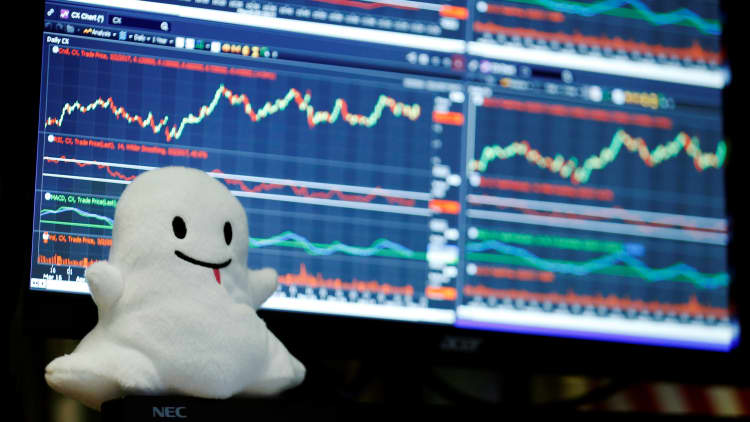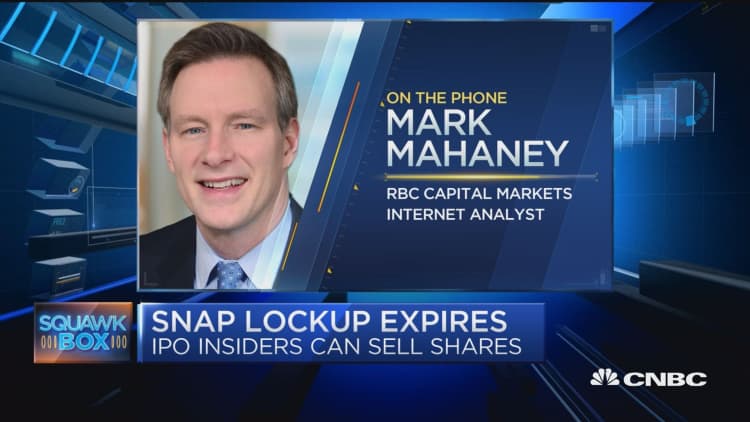
Snap's stock whipsawed this month, with Wall Street analysts torn on whether the shares are worth more or less than the $17 IPO price it received in March. And it's about to face its biggest challenge in a while, as its lockup period ends.
Among finance types, one explanation of Snap's unrest has been the timing of the massive public offering.
Paul Meeks, chief investment officer and portfolio manager at Sloy Dahl & Holst, told CNBC this month that Snap should have waited to go public since its business model was too immature and susceptible to copying by Facebook's Instagram app.
But "Shark Tank's" Mark Cuban praised Snap for going public early, noting "when you're already large, it's hard to accelerate your growth."
Unfortunately, that's exactly the problem Snap encountered, adding fewer-than-expected users in the first quarter.
Indeed, for more than two years, major technology investors and CEOs have warned this would happen, chanting the mantra, "Start-ups are waiting too long to IPO." Saleforce's Marc Benioff said "entrepreneurs are making a huge mistake in waiting too long to go public."
Fred Wilson of Union Square Ventures was sounding the alarm back in 2015. "The big problem is, companies can get much better valuations in the private markets than they can in the public markets. Companies will come out and go public, and the stock will trade below where they did their last round of financing in the private market," he warned. "I think companies should be going public earlier in their life cycle so the broader public can be shareholders. I think it's not good for society for all the gains in these game-changing companies to be held between a very, very small shareholders."
So what should Snap have done differently? Go public later? Go public earlier? That's up for debate.
Bullpen Capital's Duncan Davidson is of the school of thought that Snap should have gone public "a few years ago." But, he said, bringing back the successful smaller IPO requires a whole ecosystem — one that buyers today don't have access to.
The case for going public earlier
The best-case scenario for going public early is a company like Amazon, which filed with $15.7 million in revenue in 1996, far less than the $404.48 million Snap had in 2016. (Although Amazon was growing very rapidly.)
On May 15, 1997, Amazon shares , just a dollar above Snap's $17 listing. Today, those shares are worth about , accounting for stock splits.
By buying Amazon early, many retail investors were able to get in on Amazon's meteoric growth. The dot-com bust later wiped out a lot of companies from the same era, but Davidson said that teaching responsible investing — diversifying portfolios and holding stock — could make it possible for many people to find at least one diamond in the rough.
"It's the perspective of what the buyer of the stock is expecting," Davidson said. "You would put your ten grand into Amazon and be worth ten million. That was the social contract with the retail investor."
Much has changed in the regulatory landscape since then. Regulations designed to protect investors from catastrophes like the dot-com bubble have made it less attractive for early-stage companies to go public, Davidson said. For instance, the SEC has experimented with different "tick size" ratios and confidentiality periods for IPOs, sometimes in ways that favor larger companies, Davidson said.
Right now, stock prices are decimalized — priced to the penny — making it harder for Wall Street to make money trading and releasing research note coverage on smaller stocks. The SEC is looking into whether to designate a minimum increment for the securities of "emerging growth companies" that is greater than a penny but less than 10 cents to see if it encourages more IPOs.
A similar kind of system, with larger increments, was in place until 2001. That means that when Amazon went public, there were many other nascent technology company IPOs that investors could learn about and invest in — giving investors a more diverse portfolio and making them more likely to pick a winner.
"The public market window is not really opened up," Davidson said. "We've been testing the window. Snapchat should have done better."

The case for going public later
Snap's IPO is in a much different market than Amazon's was. Instead of entering a booming, diverse landscape of public offerings, Davison said Snap faced "serious scrutiny" amid a dearth of IPOs. In 2016, 126 companies filed for IPO, the lowest level since 2009 and down from 364 in 2014, according to Renaissance Capital.
Plus, attitudes toward the stock market have changed, as more investors rely on passive investing, pushing money toward reliable returns rather than individual bets.
"You have to have enough quantity to play a portfolio," Davidson said. "The retail investor can't spread their risk around. ... Now the whole market is passive investing. No one can use their wit, you don't have access to the insider stuff in Silicon Valley."
Because of scrutiny and its high valuation, Snap was expected to face a different field of competitors: It is battling to be the next Facebook, rather than being compared to other early-stage companies, Davidson said. And if you're being compared to Facebook, the argument goes, maybe it's better to wait until you have Facebook-like fundamentals.
When Facebook went public, it was coming off a year with $3.71 billion in revenue and $1 billion in net income -- way ahead of Snap's $404 million 2016 revenue and $515 million net loss.
Then there's Snap's high private market valuation of $17.8 billion, another metric that sets the tone for investor expectations.
"There is a world of difference between a private valuation versus the public market, because there are so few involved in [the private market]," Kathleen Smith, principal at Renaissance Capital, a manager of IPO-focused ETFs, told CNBC of fellow 2017 IPO, Blue Apron.
So although Davidson thinks a seminal company like Snap should be public as soon as possible, he acknowledges it's not that easy in the current ecosystem. Snap was not immediately available to comment, but CEO Evan Spiegel has said that he "sees a benefit in having the company's value determined by public markets" and that he recognizes "there's a disconnect between how investors and much of the public want to see Snap evolve."
"They are way beyond the scale where they can shoot up just on hype," Davidson said.
WATCH: This family's been on permanent vacation since dad sold his company for $54 million



